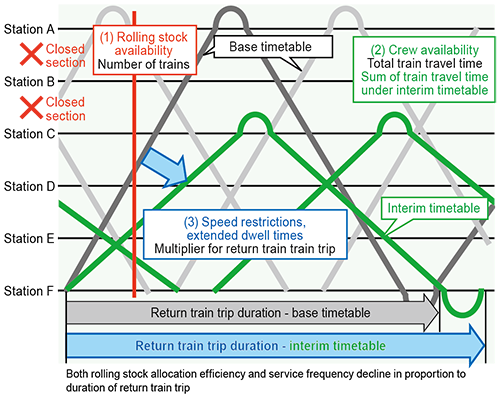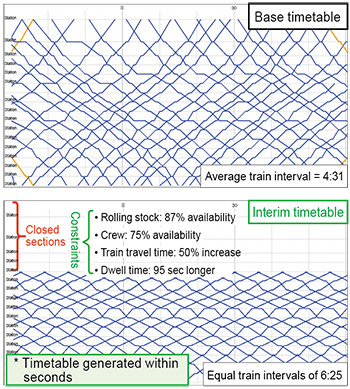27. Automatic interim timetabling algorithms in case of disasters and train crew/rolling stock shortages
In the event that trains cannot operate along with the base timetable because of crew and/or rolling stock shortages, for instance due to pandemic or natural disasters, an interim timetable with fewer trains is required. It has to take into account crew and rolling stock availability as well as other constraints such as longer travel times due to speed restrictions on some sections. Making a such timetable involves as much work for timetable planners as making a fully new timetable (see Figure 1). The interim timetable has to be renewed when the line section in operation is expanded in the restoration process of the disaster. For a busy commuter line in a big city, it takes five days or more to produce an updated timetable. We have developed a fast timetabling algorithm which can generate an interim timetable for a busy commuter line in a big city, by reducing the minimum necessary number of trains reflecting any operating restrictions.
Our timetabling algorithm calculates the frequency of trains that can be delivered, subject to constraints around crew and rolling stock availability, as the basis for a workable timetable. Where the imposition of speed restrictions causes longer travel times and reduced rolling stock allocation efficiency, the timetabling algorithm calculates the impact on service frequency by applying a multiplier to represent the increased duration of each return trip. The timetable generator also optimizes train intervals and dwell time to break the snowball effects between reduced services (which lead to longer intervals between services, more congestion and extended dwell times) and extended dwell times (which in turn lead to longer intervals between services). Thus, the interim timetable is able to provide transportation services tailored to multiple constraints with minimal delays.
In trials conducted on an operational railway line, the timetabling algorithm was able to generate an interim timetable in a matter of seconds (see Figure 2). This will greatly assist with business continuity planning (BCP) in the event of natural disasters or pandemics.


